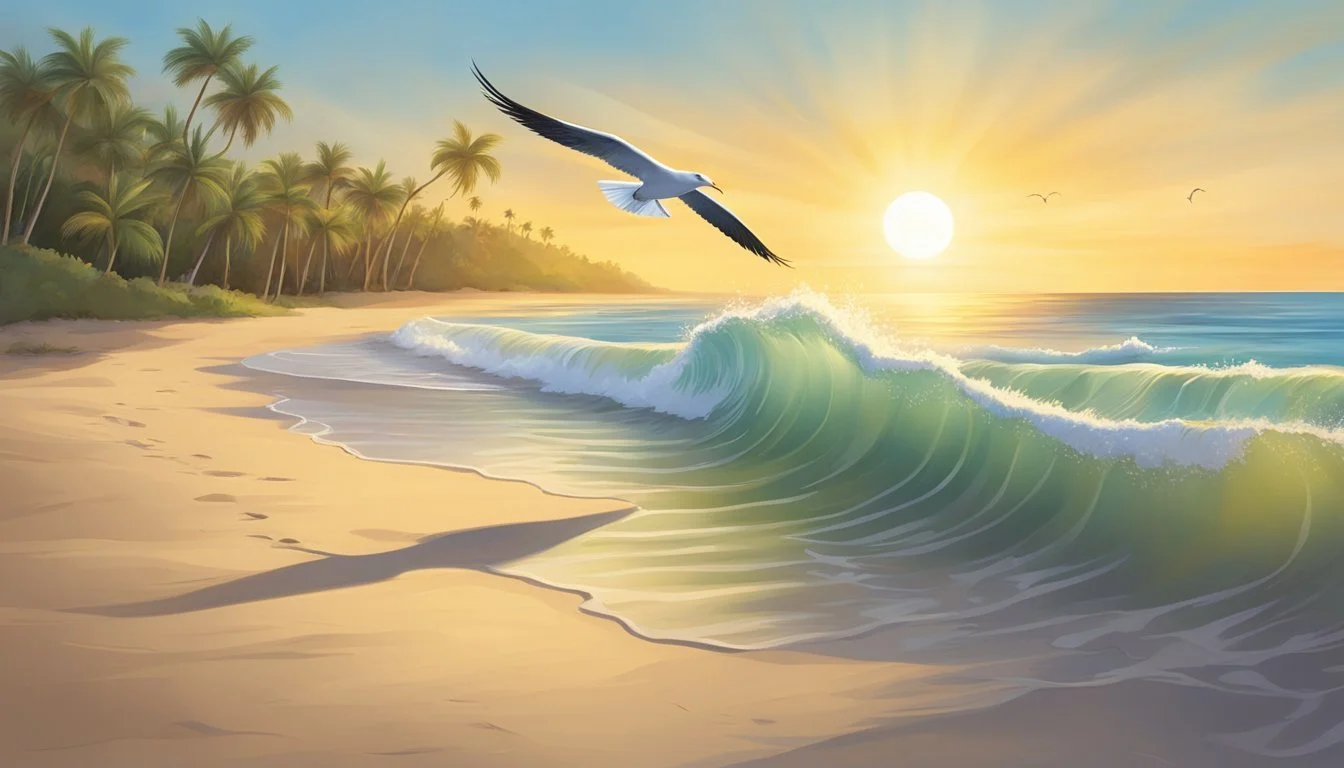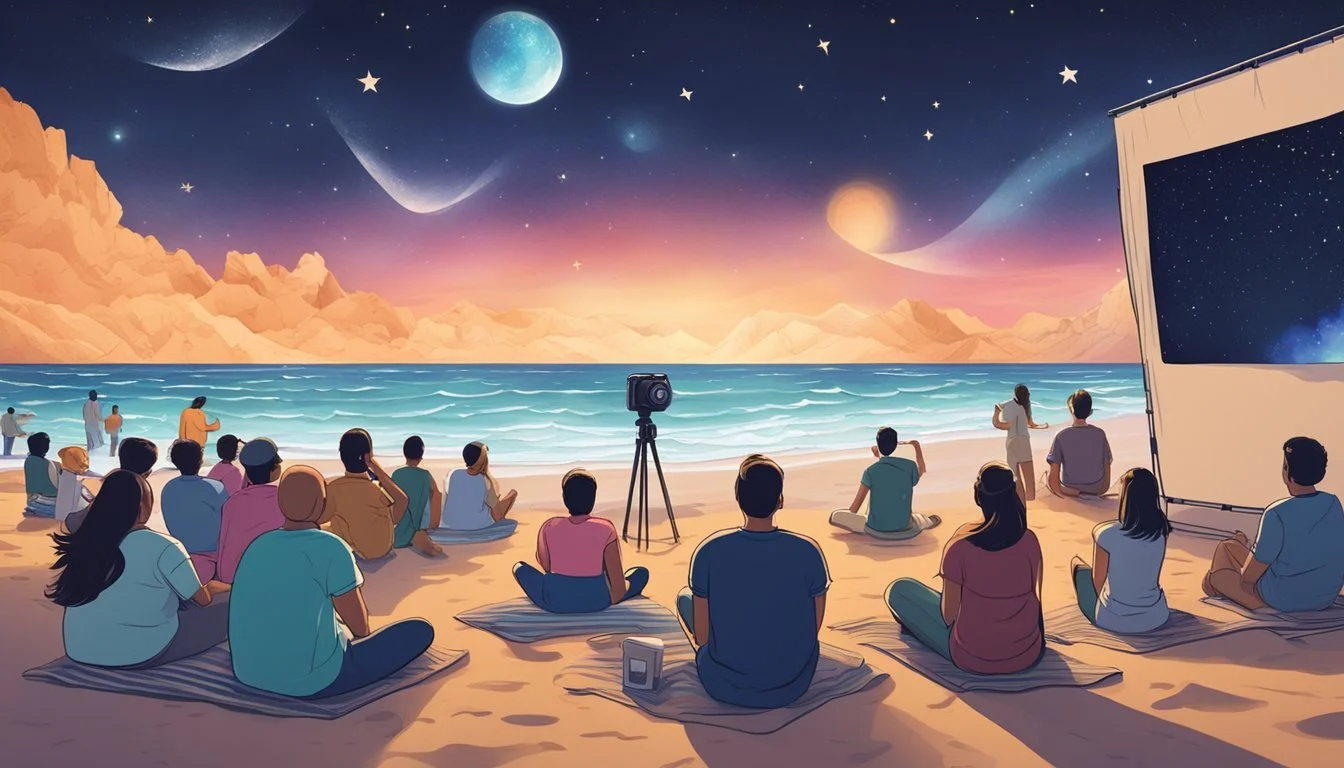Surf's Up! How "Endless Summer" Changed the World and Might Change Your Life
"The Endless Summer" stands as a landmark surf documentary that captured the imagination of audiences worldwide. Released in 1966, this iconic film follows two young California surfers on a global quest for the perfect wave.
Bruce Brown's masterpiece revolutionized surf culture and introduced millions to the allure of riding waves. The documentary showcases stunning footage of pristine beaches, exotic locales, and graceful surfing set against a backdrop of endless summer days.
Brown's innovative approach blended adventure, humor, and breathtaking cinematography to create a timeless portrait of surfing's golden age. The film's enduring popularity stems from its ability to transport viewers to sun-soaked shores and inspire dreams of endless summer pursuits, making it a must-see for surf enthusiasts and adventure seekers alike.
Creation of The Endless Summer
The iconic surf documentary "The Endless Summer" emerged from a combination of passion, vision, and serendipity. Bruce Brown's groundbreaking film captured the essence of surf culture and the pursuit of the perfect wave.
Concept and Inspiration
The concept for "The Endless Summer" arose from Bruce Brown's desire to showcase surfing's global appeal. Brown, a California-based filmmaker, had already produced several surf movies in the early 1960s. His experiences traveling and filming surfers around the world sparked the idea of following summer around the globe.
The film's inspiration came from the surfing lifestyle in California, where surfers dreamed of endless warm days and perfect waves. Brown envisioned a journey that would allow surfers to chase summer year-round, experiencing diverse surf spots and cultures.
Bruce Brown's Vision
Brown's vision for "The Endless Summer" was to create a film that would appeal to both surfers and non-surfers alike. He aimed to capture the spirit of adventure and the beauty of surfing in a way that hadn't been done before.
The filmmaker's approach was unique for its time. He combined stunning surf footage with humorous narration and a lighthearted tone. Brown wanted to showcase the joy and freedom of surfing while also educating viewers about the sport and the places visited.
His vision included following two surfers, Mike Hynson and Robert August, as they traveled the world in search of the perfect wave.
Funding and Production
Funding "The Endless Summer" proved challenging initially. Brown financed the project himself, using money from his previous films and personal savings. The production was a lean operation, with Brown serving as director, cameraman, and narrator.
The filming took place in 1963 and 1964, spanning locations in Africa, Australia, New Zealand, Tahiti, Hawaii, and California. Brown used a 16mm camera to capture the action, often filming from the beach or in the water.
Post-production was completed in 1964, with Brown editing the film and adding his distinctive narration. The soundtrack, featuring music by The Sandals, became an integral part of the film's appeal.
"The Endless Summer" was released in 1966 and quickly became a cultural phenomenon, transcending the surf community and gaining mainstream success.
The Journey Begins
The Endless Summer documentary's legendary journey began with two young surfers departing California in search of the perfect wave. Their global odyssey would take them to exotic locales and unexplored surf spots, forever changing the sport of surfing.
Embarking from California
Mike Hynson and Robert August set out from the sunny shores of California in 1963. The two talented surfers were hand-picked by filmmaker Bruce Brown to star in his groundbreaking surf documentary.
Their adventure started with a flight to Senegal, West Africa. From there, they crisscrossed the globe, chasing summer and perfect waves. The pair traveled with minimal gear - just their surfboards and a sense of adventure.
Brown captured their journey on 16mm film, documenting not just the surfing, but the cultures and people they encountered along the way.
The Quest for the Perfect Wave
Hynson and August's search for the ideal surfing conditions took them to beaches around the world. They rode waves in Nigeria, Ghana, and South Africa. The duo continued on to Australia, New Zealand, and Tahiti.
Their quest culminated in the discovery of Cape St. Francis in South Africa. Here, they found what many considered the "perfect wave" - long, glassy, and seemingly endless.
This moment became the centerpiece of the film. It showcased the thrill of discovery and the pure joy of surfing pristine, uncrowded waves. The footage captured at Cape St. Francis helped cement The Endless Summer's place in surfing lore.
Global Surf Adventures
Surfing pioneers embarked on worldwide quests to discover perfect waves. Their journeys spanned multiple continents and tropical paradises, shaping the sport's global culture.
Hawaii and Australia
Hawaii's North Shore became a mecca for big wave surfing. Waimea Bay and Pipeline drew thrill-seekers from around the globe. Surfers tested their skills against massive swells and reef breaks.
Australia's Gold Coast emerged as another surfing hotspot. Spots like Snapper Rocks and Burleigh Heads offered consistent waves year-round. The region's surf culture flourished, producing champion surfers and innovative board designs.
Both destinations hosted major competitions. These events attracted top talent and media attention, further cementing their status in surf history.
Africa's Coastal Pursuits
South Africa's coastline captivated surf explorers. Cape St. Francis gained fame for its perfect waves, as featured in "The Endless Summer."
Jeffrey's Bay became renowned for its long, right-hand point break. Surfers flocked to experience its world-class waves.
Durban's warm waters and beach breaks provided ideal conditions for learners and pros alike. The city developed a thriving surf scene and industry.
Morocco's Atlantic coast offered powerful waves and empty lineups. Spots like Taghazout became popular among European surfers seeking winter escapes.
Exploration in New Zealand and Tahiti
New Zealand's diverse coastline presented a variety of surf opportunities. Raglan's left-hand point break gained international recognition for its length and quality.
The country's rugged beaches and remote locations appealed to adventurous surfers. Consistent swells and uncrowded waves rewarded those willing to explore.
Tahiti's Teahupo'o became legendary for its heavy, barreling waves. The spot's intense reef break challenged even the most skilled surfers.
French Polynesia's islands offered pristine beaches and perfect waves. Surfers discovered idyllic setups in places like Moorea and the Tuamotu Archipelago.
The Cultural Impact
The Endless Summer documentary profoundly shaped surf culture and left an enduring legacy. It introduced surfing to mainstream audiences and inspired generations of wave riders worldwide.
Influence on Surf Culture
The Endless Summer, released in 1966, transformed surfing from a niche activity into a global phenomenon. The film's portrayal of American surfers Mike Hynson and Robert August traveling the world in search of the perfect wave captured the imagination of viewers far beyond coastal communities. It popularized the idea of surf travel and the laid-back lifestyle associated with the sport.
The documentary's stunning cinematography and exotic locations fueled interest in surfing as both a sport and a way of life. It sparked a surge in surf tourism, with enthusiasts flocking to beaches featured in the film. The Endless Summer also influenced fashion, music, and language, introducing surfing slang and style to mainstream culture.
The Endless Summer's Legacy
More than five decades after its release, The Endless Summer continues to inspire surfers and filmmakers alike. Its impact is evident in the numerous surf documentaries and films that followed, many of which sought to capture the same sense of adventure and freedom.
The film's legacy extends beyond surfing, influencing broader cultural trends. It helped shape the California lifestyle image that became globally influential. The Endless Summer's themes of youth, freedom, and the pursuit of happiness resonated with the 1960s counterculture movement and continue to appeal to new generations.
The documentary's enduring popularity led to a sequel and various remasters, ensuring its place in cinematic history. It remains a touchstone for surf culture, frequently referenced and celebrated in exhibitions, books, and newer surf-related media.
Soundtrack and Cinematography
"The Endless Summer" documentary's visual and auditory elements played a crucial role in capturing the essence of surf culture. The film's distinctive soundtrack and innovative cinematography techniques created an immersive experience for viewers.
Musical Score by The Sandals
The Sandals, a surf rock band, composed and performed the iconic soundtrack for "The Endless Summer". Their music perfectly complemented the film's laid-back atmosphere and adventurous spirit. The main theme, with its memorable guitar riffs, became synonymous with surf culture.
The soundtrack featured instrumentals that enhanced key moments in the documentary. Songs like "Theme from The Endless Summer", "6 Pac", and "Scrambler" added depth to the surfing sequences and travel montages.
The Sandals' music helped set the mood for each location visited in the film. Their sound captured the essence of 1960s California surf culture, blending elements of rock and jazz.
Visual Style and Techniques
Bruce Brown, serving as both director and cinematographer, employed innovative techniques to capture stunning surfing footage. He used waterproof housing for his 16mm camera, allowing him to film from within the waves.
Brown's cinematography showcased the beauty of various surf locations around the world. He captured wide shots of pristine beaches and close-ups of surfers riding waves, creating a visually engaging narrative.
The film's color photography was vibrant and crisp, highlighting the azure waters and golden sands of each destination. Brown's framing and composition emphasized the grace and skill of the surfers.
Time-lapse sequences and panoramic views added variety to the visual storytelling. These techniques helped convey the passage of time and the vastness of the landscapes encountered during the global surf odyssey.
Distribution and Reception
The Endless Summer achieved widespread distribution and garnered critical acclaim upon its release. The film's unique subject matter and stunning cinematography resonated with audiences and critics alike.
Theatrical Release
The Endless Summer initially premiered in 1964 with limited showings in California. Brown narrated these early screenings live, adding a personal touch to the experience. In 1966, the film received a wider theatrical release, expanding its reach beyond surf culture enthusiasts. Cinema V distributed the documentary, helping it find audiences across the United States. The film's success in theaters was unexpected, considering its niche subject matter. It grossed over $30 million domestically, a significant sum for an independent documentary at the time.
Critical Acclaim and Reviews
Critics praised The Endless Summer for its groundbreaking approach to surf documentaries. The film holds a 100% approval rating on Rotten Tomatoes, reflecting its enduring appeal. Reviewers commended Brown's narration style, often describing it as witty and engaging. The cinematography, capturing pristine waves and exotic locations, received particular acclaim. Many critics noted the film's ability to transport viewers to far-flung surfing destinations. The documentary's cultural impact led to its preservation in the United States National Film Registry in 2002, recognizing its historical significance.
Expanding The Endless Summer Universe
The Endless Summer's impact extended beyond the original film, spawning sequels and inspiring related media. Its influence shaped surf culture and travel documentaries for decades to come.
Sequels and Follow-ups
The success of The Endless Summer led to several follow-up films. In 1994, Bruce Brown released The Endless Summer II, revisiting the concept with a new generation of surfers. The film explored more exotic locations and showcased the evolution of surfing techniques.
In 2000, Bruce Brown's son Dana directed The Endless Summer Revisited. This documentary incorporated unused footage from the original film and its sequel, providing additional insights into the making of the classics.
The Birth of The Endless Summer, released in 2022, delved into the untold story behind the original documentary. It followed Dick Metz's global adventures from 1958-1961, which inspired the iconic film.
Related Literature and Media
The Endless Summer's popularity sparked a wave of surf-related books and magazines. Surf journals began featuring more travel stories, encouraging readers to seek out new waves around the world.
Photography books capturing the essence of surf culture gained prominence. These visual compilations often included behind-the-scenes shots from The Endless Summer and its sequels.
Online platforms like the Internet Archive now host digitized versions of surf magazines and rare footage related to The Endless Summer, allowing fans to explore the film's cultural context.
Documentaries about surfing pioneers, including Dick Metz, emerged. These films explored the personal stories of individuals who shaped the sport and contributed to its global appeal.
Supporting The Narrative
Effective storytelling and audience connection are crucial elements in documentary filmmaking. These factors contribute to the impact and longevity of works like "The Endless Summer" and its successors.
Role of the Filmmaker
Bruce Brown's approach to crafting "The Endless Summer" set a new standard for surf documentaries. His narrative style blended humor, adventure, and cultural exploration. Brown's voiceover narration guided viewers through the global surf odyssey, making the subject accessible to non-surfers. He skillfully balanced technical surfing footage with human interest stories, creating a universal appeal.
The filmmaker's choice to focus on two relatable protagonists, Mike Hynson and Robert August, allowed audiences to connect with their journey. Brown's camera work captured not only the surfing action but also the landscapes and local cultures encountered along the way.
Audience Engagement
"The Endless Summer" resonated with viewers by tapping into the universal desire for adventure and escapism. The film's portrayal of an endless pursuit of perfect waves across the globe captured imaginations worldwide. Its success stemmed from making surfing culture accessible to a broader audience beyond the coastal communities.
The documentary's engaging narrative structure kept viewers invested in the surfers' quest. Brown's lighthearted commentary and the surfers' genuine reactions to new experiences created moments of humor and authenticity. The film's iconic poster, featuring silhouetted surfers against a sunset backdrop, became a cultural symbol that extended its reach beyond the surfing community.
Outreach and Accessibility
The "Endless Summer" documentary expanded its reach beyond theaters, embracing new platforms and audiences worldwide. This broadened access introduced surfing culture to diverse communities and educational settings.
Educational Significance
"Endless Summer" found its way into classrooms, sparking interest in geography, cultural studies, and oceanography. Schools incorporated the film into curricula, using it to teach about different cultures and coastal environments. The documentary's vivid portrayal of global surf spots inspired students to learn about places like Senegal, Ghana, and Nigeria.
Universities added the film to media studies programs, analyzing its cinematography and cultural impact. Surf clubs at colleges used it to recruit new members and promote environmental awareness. The film's enduring popularity made it a valuable tool for educators seeking to engage students with visual storytelling.
Global Availability and Licensing
"Endless Summer" expanded its reach through various streaming platforms. Netflix included it in its documentary lineup, exposing new generations to the classic film. Tubi, a free streaming service, made the documentary accessible to viewers without subscription fees. The Internet Archive hosts clips and related materials, ensuring preservation and easy reference.
Universal access efforts led to subtitles and dubs in multiple languages. This allowed non-English speakers to enjoy the film's narrative and visuals. Licensing agreements with international broadcasters brought "Endless Summer" to television networks in countries far from coastlines, spreading surf culture globally.
Digital restoration efforts improved the film's quality for modern viewing devices. This enhancement preserved the documentary's iconic imagery for future audiences to appreciate.
Community and Cultural Exchanges
The "Endless Summer" documentary sparked meaningful interactions between surfers and local communities worldwide. It played a key role in promoting surfing culture across different countries and continents.
Interactions with Local Communities
Surfers featured in "The Endless Summer" engaged with locals in South Africa, Australia, and Hawaii. These encounters led to cultural exchange and mutual learning. In South Africa, the surfers introduced the sport to curious onlookers, sharing techniques and equipment.
Australian surf communities welcomed the travelers, offering insights into local wave conditions and surf spots. This fostered friendships and expanded the global surf network.
In Hawaii, already a surfing hub, the visitors experienced traditional Hawaiian surf culture firsthand. They gained deeper appreciation for the sport's Polynesian roots.
Promoting Surfing Worldwide
"The Endless Summer" significantly boosted surfing's popularity globally. The film showcased beautiful beaches and perfect waves in lesser-known locations, inspiring viewers to explore new surf destinations.
South Africa saw a surge in surf tourism after the movie's release. Local economies benefited from increased visitors seeking the perfect wave.
The documentary's success led to more surf movies, further spreading surf culture. These films highlighted different aspects of surfing lifestyles and techniques.
Surfing gained recognition as both a sport and a lifestyle. It attracted new enthusiasts in countries previously unfamiliar with the activity. The film's impact continues to influence global surf culture today.








